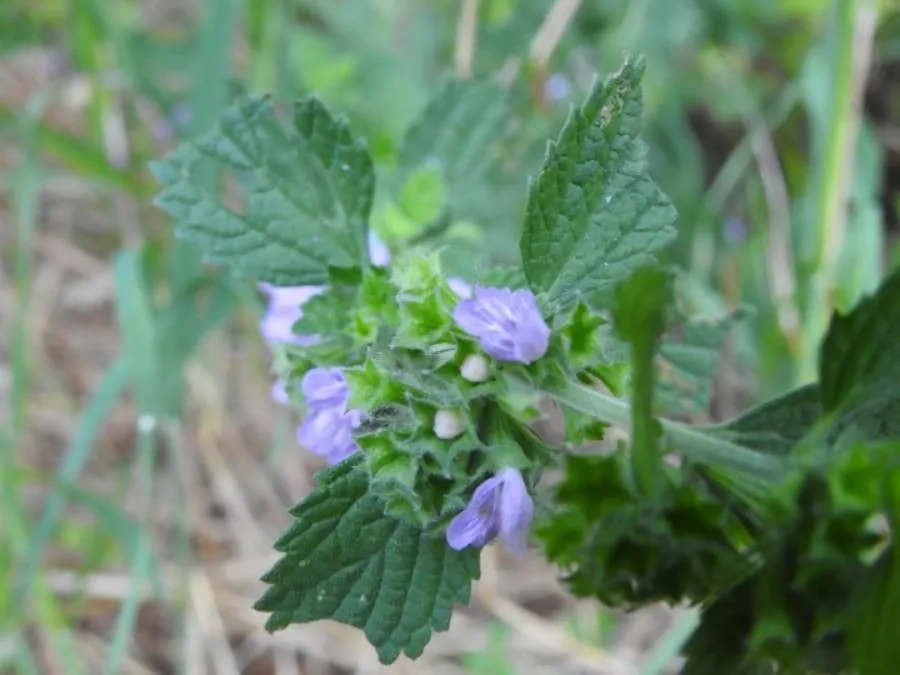
Author: L.
Bibliography: Sp. Pl.: 582 (1753)
Year: 1753
Status: accepted
Rank: species
Genus: Ballota
Vegetable: False
Observations: Macaronesia, Europe to Medit. and Iran
Black horehound, scientifically known as Ballota nigra, is a noteworthy herb belonging to the Lamiaceae family. First described in 1753, it has since garnered attention for its distinctive characteristics and extensive geographical distribution. This resilient plant can be found across a diverse range encompassing Macaronesia, Europe, the Mediterranean region, and stretching as far as Iran.
Characterized by its hairy, somewhat uninviting appearance, Black horehound forms bushy clumps with serrated, heart-shaped leaves that exude a strong, unpleasant odor when crushed. In summer, it produces clusters of small, tubular flowers, usually in shades of pink or purple, arranged in whorls around the upper parts of the stems. These blossoms are complemented by a calyx that is covered in fine, woolly hairs, providing the plant with a somewhat muted, silvery-green hue.
Despite its less appealing scent, Black horehound has a long history of usage in traditional herbal medicine. Historically, it has been employed to treat a variety of ailments, particularly for its supposed antiemetic properties, making it a popular choice to address nausea and vomiting. However, it is less commonly used in modern herbal practices compared to other members of the Lamiaceae family.
The plant thrives in environments that offer plenty of sunlight and well-drained soil, commonly appearing in wastelands, along roadsides, and in other disturbed areas. Its hardy nature allows it to withstand less-than-ideal growing conditions, making it a persistent presence in its native and introduced habitats.
Understanding the role of Black horehound in the ecosystem, it serves not only as a medicinal plant but also plays a part in the local flora, providing nectar for pollinators during its flowering season. As such, while Ballota nigra may not be the most glamorous or sweet-smelling herb, its resilience and historical significance render it a fascinating subject in the botanic world.
Eng: black horehound, fetid horehound
Deu: schwarznessel, stinkandorn
Dan: tandbæger
Spa: ballota, balota, marrubio bastardo, marrubio negro
Fra: ballote vulgaire, ballote noire
Swe: bosyska, porro, bonässla
Nno: hunderot
Nob: hunderot
Lav: meln
Est: must karunõges
Fin: porro
Nld: stinkende ballote, ballote, echte en stinkende ballote
Cym: anwydlys, banadlen ddu, danhadlen ddu, drewsawr, marddanadlen ddrewsawr, marddanhadlen ddu, marddynad, marddynad ddrewsawr, marddynad ddu, marwddanhadlen
En: Black horehound, Fetid horehound, Black Ballota
Ar: دانة سوداء
Be: Белакудранік чорны
Bg: Капела
Ca: Malroig negre, Malrubí negre, Malrubí pudent, Marreu negre, Ortiga borda, Ortiga pudent, Malrubí bord
Kw: Les mosek
Cs: Měrnice černá
Da: Rød Tandæger, Tandbæger
Nl: Echte en Stinkende ballote, Stinkende ballote, Ballote
Et: Must karunõges
Fi: Porro, Karvanokkonen, Valkoporro, Tummaporro
Fr: Ballote vulgaire, Ballote noire, Ballote, Marrube noir
De: Stinkandorn, Schwarznessel, Gewöhnliche Schwarznessel, Schwarzer Gottvergess, Stink-Andorn, Schwarzer Gottvergeß
He: בלוטה שחורה, גלונית מבאישה
Hu: Fekete peszterce
Ga: Grafán dubh
It: Cimiciotta comune, Marrubio selvatico
Lv: Meln
No: Hunderot
Nb: Hunderot
Nn: Hunderot
Fa: بالتا نیگرا
Pl: Mierznica czarna
Ru: Белокудренник чёрный
Sk: Balota čierna
Es: Ballota, Balota, Marrubio bastardo, Marrubio negro, Ballote negro, Balote, Manrubio bastardo, Manrubio fétido, Manrubio negro, Manrubio, Marrubio falso, Marrubio fétido, Marrubio hediondo, Marrubio negro de El Paular, Marrubio negro segoviano, Marrubio, Matranzo, Ortiga blanca, Ortiga borde, Ortiga mansa, Ortiga muerta, Prasio negro, Črna lahkotnica
Sv: Bosyska, Bonässla, Porro
Tt: Кара көдрә чәчәк
Uk: М’яточник чорний
Cy: Marddanhadlen ddu, Anwydlys, Banadlen Ddu, Danhadlen Ddu, Drewsawr, Marddanadlen Ddrewsawr, Marddynad, Marddynad Ddrewsawr, Marddynad Ddu, Marwddanhadlen
Taken Jun 11, 2018 by Pep Secem (cc-by-sa)
Taken Jun 11, 2018 by Pep Secem (cc-by-sa)
Taken Jun 11, 2018 by Pep Secem (cc-by-sa)
Taken Jun 11, 2018 by Pep Secem (cc-by-sa)
Taken Jun 11, 2018 by Pep Secem (cc-by-sa)
Taken Oct 16, 2022 by Nathalie Potel (cc-by-sa)
Taken Oct 16, 2022 by Nathalie Potel (cc-by-sa)
Taken May 28, 2018 by jose (cc-by-sa)
Taken Jul 1, 2019 by Росток Анфиса (cc-by-sa)
Taken Jun 11, 2018 by Pep Secem (cc-by-sa)
Taken Jul 16, 2020 by Karen Vorberg (cc-by-sa)
Taken Aug 30, 2014 by Tela Botanica − Dominique REMAUD (cc-by-sa)
Taken Aug 30, 2014 by Tela Botanica − Dominique REMAUD (cc-by-sa)
Taken Jun 28, 2021 by Alain Bigou (cc-by-sa)
Taken Aug 10, 2022 by Andrzej Konstantynowicz (cc-by-sa)
Taken Aug 26, 2021 by 🐞Hélène🐦 (cc-by-sa)
Taken Aug 26, 2021 by 🐞Hélène🐦 (cc-by-sa)
Taken Jun 28, 2021 by Alain Bigou (cc-by-sa)
Taken Aug 26, 2021 by 🐞Hélène🐦 (cc-by-sa)
Taken Jun 9, 2018 by Roberto Dessì (cc-by-sa)
Taken Oct 21, 2022 by Avi (cc-by-sa)
Taken Sep 29, 2022 by Emma Franklin (cc-by-sa)
Taken Jul 11, 2022 by Dominik Muczyński (cc-by-sa)
Taken Jun 9, 2018 by Roberto Dessì (cc-by-sa)
Taken Jul 1, 2019 by Росток Анфиса (cc-by-sa)
Taken Jun 2, 2019 by spera susianum (cc-by-sa)
Taken May 22, 2020 by elodie cottrell (cc-by-sa)
Taken Jul 31, 2009 by EOL − Michael Wunderli (cc-by)
Taken Oct 10, 2021 by Manuel Barón (cc-by-sa)
Taken Aug 6, 2022 by Nathalie Potel (cc-by-sa)
© copyright of the Board of Trustees of the Royal Botanic Gardens, Kew.
© copyright of the Board of Trustees of the Royal Botanic Gardens, Kew.
© copyright of the Board of Trustees of the Royal Botanic Gardens, Kew.
Growth habit: Forb/herb
Ph maximum: 7.5
Ph minimum: 7.0
Light: 7
Atmospheric humidity: 5
Bloom months: [‘may’, ‘jun’, ‘jul’, ‘aug’, ‘sep’]
Soil nutriments: 8
Family: Myrtaceae Author: (F.Muell.) K.D.Hill & L.A.S.Johnson Bibliography: Telopea 6: 402 (1995) Year: 1995 Status:…
Family: Rubiaceae Author: Pierre ex A.Froehner Bibliography: Notizbl. Bot. Gart. Berlin-Dahlem 1: 237 (1897) Year:…
Family: Sapindaceae Author: Koidz. Bibliography: J. Coll. Sci. Imp. Univ. Tokyo 32(1): 38 (1911) Year:…
Family: Asteraceae Author: A.Gray Bibliography: Pacif. Railr. Rep.: 107 (1857) Year: 1857 Status: accepted Rank:…
Family: Fabaceae Author: Medik. Bibliography: Vorles. Churpfälz. Phys.-Ökon. Ges. 2: 398 (1787) Year: 1787 Status:…
Family: Aspleniaceae Author: (Cav.) Alston Bibliography: Bull. Misc. Inform. Kew 1932: 309 (1932) Year: 1932…